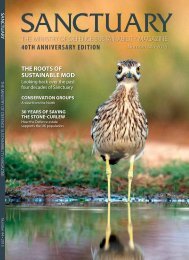SUSTAINABILITY
UC30G
UC30G
You also want an ePaper? Increase the reach of your titles
YUMPU automatically turns print PDFs into web optimized ePapers that Google loves.
FEATURES<br />
Animal carvings from Torrs Cave<br />
The ‘sea monster ’. The head is only 3cm wide, probably engraved with a sharp tool © Dumfries and Galloway Museums Service<br />
The coast of Dumfries and Galloway<br />
is riddled with caves. One of the most<br />
intriguing of these is Torrs Cave which<br />
lies on the Dundrennan Training Range,<br />
within Kirkcudbright Training Area.<br />
The historical and archaeological<br />
significance of Torrs Cave was first<br />
noted in the 1790s when high stone<br />
walls at the mouth of the cave could<br />
still be seen. These structures and<br />
occupation layers within the cave itself<br />
were excavated in the 1930s and finds<br />
suggested occupation from the Iron<br />
Age to the 18th century.<br />
In 1977 a German cave and mine<br />
explorer found two small carvings at<br />
the very end of the cave. One was of a<br />
stag and the other of some sort of sea<br />
monster. He realised that they were<br />
potentially important, cut them from<br />
the cave wall and took them to the<br />
Stewartry Museum in Kirkcudbright for<br />
identification. They were subsequently<br />
sent to Glasgow Museum where<br />
archaeologist Jack Scott reported the<br />
stag carving as possibly of Iron Age<br />
date and the monster as Scandinavian<br />
in style, possibly dating back to the 9th<br />
or 10th century.<br />
The cave was revisited in 2014 to assess<br />
its archaeological significance and see<br />
if any other carvings could be found.<br />
The cave is just over 20m long. The<br />
impressive entrance is 6m high and<br />
some 4m wide and the prehistoric and<br />
medieval walls uncovered during the<br />
excavations in the 1930s can still be<br />
seen. Beyond the entrance is a large<br />
chamber, with intact archaeological<br />
deposits, which leads to a narrow rift<br />
about 1.5m wide. It is at the end of<br />
this rift, close to the cave floor, that<br />
the carvings were found in the 1970s.<br />
Unfortunately, and despite a careful<br />
search, no other carvings were located.<br />
But both walls at the end of the cave<br />
were found to be covered in 19th<br />
century graffti – the earliest dated<br />
name is 1800. Investigation of the cave<br />
was made more interesting by the<br />
presence of a large colony of European<br />
cave spiders Meta menardi and, in<br />
winter, hibernating herald moths<br />
Scoliopter yx libatrix.<br />
A number of experts have been<br />
consulted about the carvings and<br />
opinions differ. There seems to be<br />
general agreement that the stag could<br />
be later prehistoric, probably Iron Age.<br />
T his fits with the evidence from<br />
the excavations which show that<br />
the cave was used in the first and<br />
second centuries AD. The monster<br />
car ving is proving more contentious.<br />
Some have agreed with the original<br />
suggestion of a 9 th or 10th centur y<br />
date and seen similarities with<br />
dragon heads on Viking-period<br />
sculpture in nor thern England.<br />
Others think a later medieval date is<br />
more likely and a few have suggested<br />
that both car vings may be 19 th<br />
centur y graf fiti.<br />
So the panel is still out on the date<br />
or dates of these car vings. What we<br />
do know however is that engravings<br />
of this t ype are exceedingly rare and<br />
make Torrs Cave a unique site within<br />
the wider MOD estate. The car vings<br />
remain in the good care of the<br />
Stewar tr y Museum.<br />
John Pickin<br />
Former curator Stranraer Museum<br />
and member of the West Freugh<br />
Conservation Group<br />
David Devereux<br />
Former curator<br />
Stewartry Museum<br />
Sanctuary 44 • 2015<br />
41



